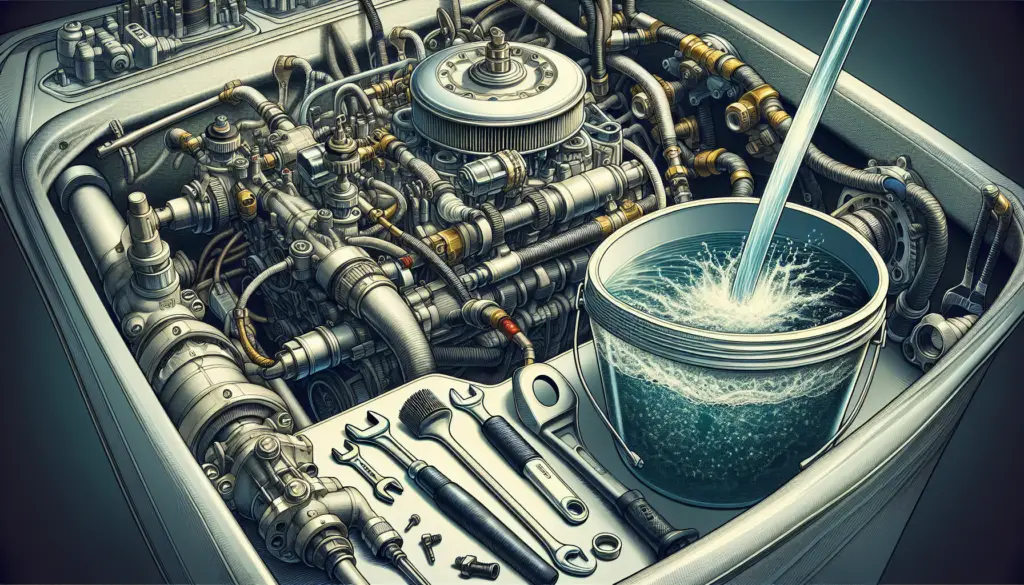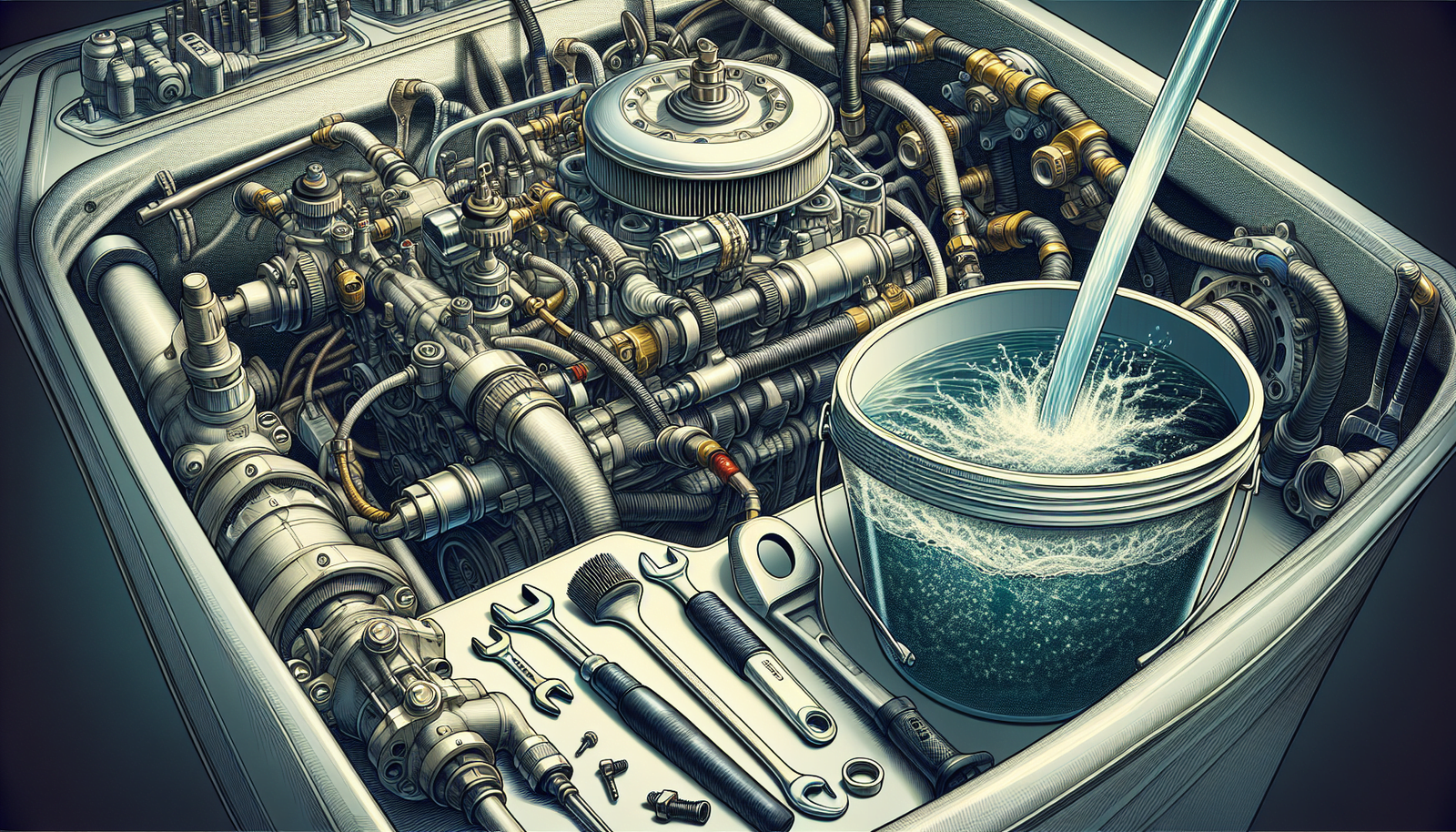Embarking on a boat engine fuel system flush might seem like a daunting task, but fear not, because this comprehensive guide will make things easier for you. Providing simple, step-by-step instructions, it ensures that even those new to boating will be able to complete the procedure with ease. By the end of this troubleshooting journey, your boat’s engine fuel system will be running smoothly and efficiently, all thanks to your newfound skills. So, grab your tools and let’s get those hands dirty. Time to give your boat the love and care it deserves!

Understanding the Importance of Fuel System Flushing
Understanding the importance of fuel system flushing is essential for any boat owner. Fuel system flushing plays a crucial role in maintaining the overall performance of your boat engine.
Highlighting the benefits of regular flushing
Regular fuel system flushing offers numerous benefits. It helps in preventing the build-up of sediments and other debris in your boat engine fuel system, ensuring uninterrupted and efficient fuel flow. This prevents engine failure and extends the longevity of your engine. Regular flushing also enhances fuel efficiency and results in smoother engine performance.
Explaining the impact of neglecting the flushing procedure
Neglecting the flushing procedure can have serious repercussions on the performance and life span of your boat engine. Over time, sediments and impurities may accumulate in the fuel system, which can block the fuel lines, mix with the fuel and lower its quality. Such issues can cause engine failures, lower its performance and shorten its lifespan.
Discussing potential problems caused by unclean fuel system
An unclean fuel system can cause a myriad of problems. It can lead to poor fuel economy, reduced engine power, irregular engine operation, and eventually, engine failure. Furthermore, the grime and sediment buildup in the fuel system can cause damage to various components, leading to costly repairs.
Identifying the Proper Tools and Materials
Performing a fuel system flush requires certain tools and materials. Having the right set ensures the success of the procedure.
Listing the tools needed for the process
The essential tools for this process include a fuel line disconnect tool, a fuel tank draining kit, fuel-resistant containers, and protective gloves. You may also need a fuel line clamp, and a basic wrench set.
Discussing the specifications of the required materials
The primary material you will require is a fuel system flushing agent. Choose a high-quality product designed to effectively clean and maintain the fuel system of boat engines.
Guide on where and how to purchase these tools and materials
Marine supply stores and online retailers both have the necessary tools and materials for fuel system flushing. Make sure to purchase from reputable sellers. Reading customer reviews and asking for recommendations from other boat owners can also be beneficial in guiding your purchases.
Getting Familiar With the Fuel System Components
Understanding the various fuel system components is a crucial step in successful fuel system flushing.
Description of the basic components
The basic components of the boat engine fuel system include the fuel tank, fuel pump, fuel filter, carburetor or fuel injector, and fuel lines.
Understanding the function of each part
Each part of the fuel system serves an important function. The fuel tank stores the fuel, the fuel pump moves the fuel from the tank to the engine, the fuel filter removes impurities, the carburetor or fuel injector mixes the fuel with air and delivers it to the engine, and the fuel lines transport the fuel through each step.
Brief discussion on how the different parts work together
The different parts work together to ensure that the engine gets the right amount of clean fuel for efficient functioning. Understanding this system helps you identify issues early and address them appropriately.
Preparation Before Flashing
Before flushing the boat’s fuel system, it is essential to prepare for the process to ensure safety and efficiency.
Safety procedures to follow
Always wear protective gear, such as gloves and safety goggles, when working with fuel. Work in a well-ventilated area and keep a fire extinguisher nearby. Also, avoid smoking or using anything that can create a spark.
Setting up the workplace
Ensure you have enough space to work and keep your tools and materials well-organized. Also, place a container under the fuel tank to catch any leaking fuel.
Preparing the boat engine for flushing
To prepare your boat engine for flushing, start by turning off the engine and disconnecting the power source. Additionally, check the overall condition of the fuel system and repair any leaks or damages before proceeding.

Step-by-Step Guide on Flushing the Boat Engine Fuel System
Performing a boat fuel system flush requires a systematic approach.
Emptying the fuel tank
Begin by disconnecting the fuel line from the fuel tank and allowing the remaining fuel to drain into a fuel-resistant container.
Disconnecting the fuel lines
Once the tank is empty, disconnect the fuel lines from their attached parts using a disconnect tool and a wrench.
Applying the flushing agent
Pour the flushing agent into the fuel tank and let it sit for the recommended duration mentioned in the product instructions.
Rinsing the fuel system
After the flushing agent has done its job, rinse the fuel system thoroughly with fresh fuel. Make sure all remnants of the flushing agent are flushed out.
Common Mistakes to Avoid During Flushing
Avoiding common mistakes during the flushing process can save you time and potential repair costs.
Bypassing safety procedures
Never bypass safety procedures. Failure to use protective gear or follow safe practices can lead to accidents and injuries.
Not completely emptying the fuel tank
Leaving fuel in the tank when flushing can dilute the flushing agent and reduces its effectiveness. Always ensure the tank is completely empty before proceeding.
Incorrect use of flushing agent
Not following the instructions of the flushing agent can lead to poor results. Always abide by the product instructions for the best outcome.
Incomplete rinsing of the system
An incomplete rinse can leave residues in the fuel system, which can negate the purpose of the flush. Always rinse the system thoroughly after applying the flushing agent.
Tips for Effective Boat Engine Fuel System Cleaning
Certain practices can significantly enhance the effectiveness of your fuel system cleansing.
Best practices to keep in mind during flushing
Always keep your tools clean and in good condition, follow the exact procedure, and don’t rush. Give the flushing agent time to work effectively.
Techniques to ensure thorough cleaning
Inspect your fuel system meticulously during the process to make sure every part is clean. Consider repeating the process if necessary.
Advice on prolonging the cleanliness of the fuel system
Use high-quality fuel, avoid storing your boat with a full fuel tank for prolonged periods, and perform regular flushing to prolong the cleanliness of the fuel system.
After Flushing Procedures
Monitoring your boat engine’s performance after flushing can provide you with assurance that the flushing procedure was completed successfully.
Monitoring the engine performance
Monitor your boat’s engine performance after the completion of the procedure. A successful flush should result in smoother operation and improved fuel efficiency.
Observing for the reappearance of symptoms
Look out for any reappearance of previously-observed symptoms such as rough running and difficulty in starting the engine. Any such occurrence might indicate incomplete flushing.
Scheduling the next cleaning
Plan for and schedule the next fuel system flushing according to your boat’s usage and manufacturers’ guidelines to ensure continuous peak performance.
Maintenance Tips for a Healthy Fuel System
Adhering to certain maintenance tips can contribute significantly to a healthy fuel system.
Regular check-ups and monitoring of your fuel tank
Ensure you conduct regular checks on your fuel tank for sediment and condensation. This helps in identifying and addressing any potential issue early.
Using the recommended fuel grade
Always use the fuel grade recommended by your boat engine’s manufacturer. This helps in maintaining an efficient fuel system and prolongs the lifespan of your engine.
Avoiding bad fuel habits
Avoid practices like letting your fuel level run too low or using old, contaminated fuel as they can facilitate the accumulation of sediments in the fuel system.
Troubleshooting Common Problems After Flushing
At times, you may encounter issues after performing a fuel system flush. Knowing how to troubleshoot these problems can save you time and money.
Identifying tell-tale signs of a problem
Any uncomfortable noises, rough engine operation, or decreased fuel efficiency are signs of a possible issue with your fuel system. Monitor your boat engine’s behavior closely after the flush.
Resolving minor issues
Understanding your boat engine fuel system allows you to resolve minor issues such as leaks or blockages without needing professional assistance.
When to seek professional help
If your boat encounters continuous issues despite your troubleshooting efforts, it is advisable to seek help from a professional. Continuing to operate a boat with a faulty fuel system might cause severe damage to the engine.


[…] main components of a boat engine’s fuel system include the fuel tank, fuel lines, fuel pump, fuel filter, and fuel injectors or carburetor. Each of these components has a critical role in […]